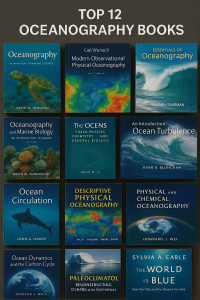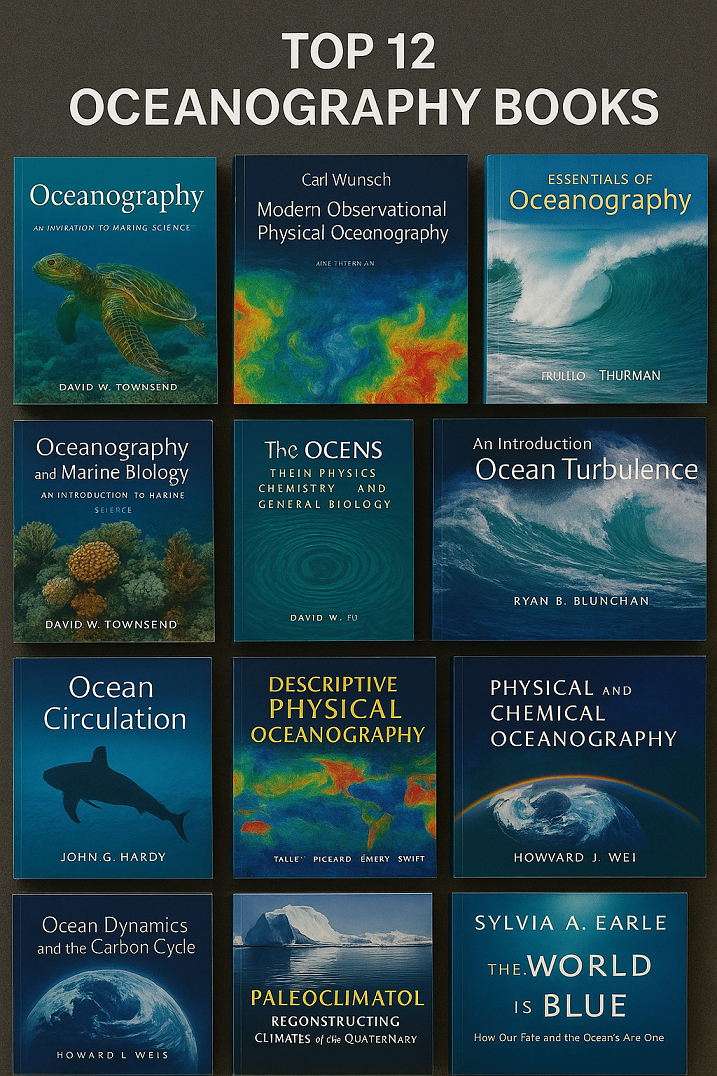 Discover the best oceanography books for maritime professionals, students, and enthusiasts. This detailed guide explores the top 12 titles shaping marine science understanding today.
Discover the best oceanography books for maritime professionals, students, and enthusiasts. This detailed guide explores the top 12 titles shaping marine science understanding today.
Understanding the world’s oceans is not only vital for scientists but also for seafarers, port operators, coastal engineers, and maritime students. Oceanography—the study of the physical, chemical, biological, and geological aspects of the ocean—plays a key role in global trade, weather prediction, resource exploration, and environmental protection. Whether you’re navigating a ship or studying marine ecosystems, having the right resources is crucial.
This guide explores 12 of the most informative, insightful, and globally respected books in oceanography. Each title is chosen based on its educational value, real-world applications, readability, and relevance to current maritime challenges.
Why Oceanography Matters in Maritime Education and Practice
From rising sea levels to the intricacies of ocean currents and climate feedback loops, oceanography offers crucial knowledge for modern maritime operations. According to the International Maritime Organization (IMO), understanding ocean patterns is essential for enhancing maritime safety, optimizing ship routing, and mitigating environmental risks (IMO, 2023).
Moreover, organizations like the World Meteorological Organization (WMO) and the Intergovernmental Oceanographic Commission (IOC) continue to collaborate on programs that link ocean science to climate resilience and sustainable development goals (SDGs). Maritime professionals who grasp these scientific foundations can make better navigational, environmental, and logistical decisions.
The Top 12 Oceanography Books
Let’s dive into the best titles that combine theory, field applications, and global perspectives.
1. “Introduction to Physical Oceanography” by Robert H. Stewart
Widely used in university curricula worldwide, Stewart’s book is a free and comprehensive guide to the physical processes of the ocean. It covers ocean currents, waves, tides, and thermohaline circulation with practical data examples.
- Why read it? It’s accessible, mathematically sound, and packed with real-world case studies.
- Best for: Marine science students, navigators, and meteorologists.
2. “The Ocean of Life: The Fate of Man and the Sea” by Callum Roberts
This engaging and emotional narrative reveals how human activity affects the ocean’s ecosystems.
- Why read it? A blend of scientific insight and advocacy, this book is especially compelling for those concerned about marine sustainability.
- Best for: Environmental officers, port authorities, policy-makers.
3. “Descriptive Physical Oceanography” by Lynne D. Talley et al.
Now in its sixth edition, this textbook remains a cornerstone for physical oceanography education.
- Why read it? Offers a global, quantitative understanding of ocean structure and circulation, referencing real ship-based observations.
- Best for: Students in maritime academies and marine engineering courses.
4. “Waves, Tides and Shallow-Water Processes” by Open University Course Team
Part of the Open University series, this book explains the dynamic processes near coasts and ports.
- Why read it? Offers excellent explanations of phenomena affecting port operations and coastal erosion.
- Best for: Port engineers, marine pilots, and surveyors.
5. “Chemical Oceanography and the Marine Carbon Cycle” by Steven Emerson and John Hedges
A high-level book addressing chemical dynamics in oceans with a focus on the carbon cycle.
- Why read it? Excellent for those exploring ocean acidification and climate change impacts.
- Best for: Marine biologists, sustainability managers, academic researchers.
6. “Marine Biology” by Peter Castro and Michael E. Huber
Combining foundational biology with marine-specific ecosystems, this book introduces the diversity of life under the sea.
- Why read it? Widely used in undergraduate marine biology programs and visually rich.
- Best for: Maritime students interested in biology, fisheries officers, marine conservationists.
7. “Ocean Circulation and Climate: A 21st Century Perspective” by Gerold Siedler, Stephen M. Griffies et al.
A comprehensive collection from leading ocean scientists on global circulation patterns.
- Why read it? Combines modeling, satellite data, and fieldwork.
- Best for: Advanced students, naval officers, maritime meteorologists.
8. “Marine Geology” by James P. Kennett
This book explains geological formations under the sea, including continental margins and deep-sea processes.
- Why read it? Crucial for understanding submarine landslides and sediment transport.
- Best for: Hydrographic surveyors, offshore engineers, geophysicists.
9. “Introduction to Ocean Sciences” by Douglas A. Segar
An introductory-level book designed for students with little science background.
- Why read it? Uses current events and oceanography news to explain principles.
- Best for: Maritime training centres, deck cadets, interdisciplinary learners.
10. “Deep: Freediving, Renegade Science, and What the Ocean Tells Us About Ourselves” by James Nestor
A narrative-driven exploration of the deep sea through freediving and ocean science.
- Why read it? Brings a human element to the otherwise technical subject.
- Best for: Maritime enthusiasts, educators, and casual readers.
11. “Oceanography and Seamanship” by William G. Van Dorn
This classic guide bridges oceanography and practical seamanship.
- Why read it? Offers mariners a way to interpret sea conditions for safer navigation.
- Best for: Ship captains, deck officers, weather routing professionals.
12. “Introduction to Marine Biogeochemistry” by Susan Libes
A detailed guide to the chemistry of marine ecosystems.
- Why read it? Addresses nutrient cycling, sediment chemistry, and environmental assessment.
- Best for: Environmental compliance officers, scientific crew members, university researchers.
Real-World Applications of Oceanographic Knowledge
In 2022, the EMSA published a study linking ocean current models with oil spill forecasting tools for European waters. These tools are directly influenced by foundational research from books like Descriptive Physical Oceanography and Chemical Oceanography.
Similarly, modern ship route optimization tools like Wärtsilä’s Fleet Operations Solution (FOS) use real-time oceanographic data. Understanding the basics of ocean currents and weather systems—topics covered in books by Stewart and Talley—can help maritime officers better interpret software outputs.
Port authorities across Europe, as reported by the European Sea Ports Organisation (ESPO), increasingly rely on coastal oceanography to plan dredging operations, sediment disposal, and shore protection. For them, Waves, Tides and Shallow-Water Processes is more than a textbook—it’s a guidebook for action.
Frequently Asked Questions
What is the best oceanography book for beginners?
- Introduction to Ocean Sciences by Segar is ideal due to its clarity and real-world examples.
Are these books suitable for non-native English speakers?
- Yes. Books like Stewart’s and Castro’s offer clear language and visual aids, perfect for global English learners.
How do oceanography books help seafarers?
- They enhance understanding of sea behavior, improve navigation safety, and support environmental decision-making.
Do I need a science background to read these books?
- Not always. Several titles are designed for interdisciplinary learners and maritime professionals from various backgrounds.
Which book is most relevant to climate change and shipping?
- Chemical Oceanography and the Marine Carbon Cycle offers essential insight into how oceans absorb CO2.
Is there a free oceanography book available?
- Yes. Robert Stewart’s Introduction to Physical Oceanography is openly available online.
Conclusion
Oceanography is more than an academic subject—it’s a practical toolkit for the maritime world. From navigating storms to assessing environmental risks, ocean knowledge drives decision-making at sea and ashore.
Whether you’re a cadet preparing for exams or a veteran captain adjusting routes in the South China Sea, the right book can deepen your understanding and sharpen your skills. These 12 books—ranging from foundational science to real-world application—should be in every maritime bookshelf.
Let your learning journey begin. Dive into these titles, and you’ll not only explore the oceans—but also navigate your career with greater clarity and confidence.
References
- IMO. (2023). Oceanographic Data and Maritime Safety. Retrieved from https://www.imo.org
- ESPO. (2023). Port Environmental Report. Retrieved from https://www.espo.be
- Stewart, R. H. (2008). Introduction to Physical Oceanography. Open Access Textbook.
- Talley, L. D., Pickard, G. L., Emery, W. J., & Swift, J. H. (2011). Descriptive Physical Oceanography. Elsevier.
- Emerson, S., & Hedges, J. (2008). Chemical Oceanography and the Marine Carbon Cycle. Cambridge University Press.
- Siedler, G., Griffies, S. M., Gould, J., & Church, J. A. (2013). Ocean Circulation and Climate. Academic Press.
- Roberts, C. (2012). The Ocean of Life: The Fate of Man and the Sea. Viking.
- NOAA. (2024). Marine Education Resources. Retrieved from https://www.noaa.gov
- Marine Insight. (2023). Top Books for Maritime Professionals. Retrieved from https://www.marineinsight.com
- Wärtsilä. (2024). Fleet Optimization Tools. Retrieved from https://www.wartsila.com

